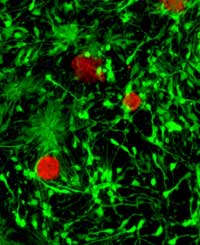The Notch effect steers stem cells into cells of the nervous system

When Notch is activated in embryonic stem cells, most turn into nerve cells (green)
Embryonic stem cells have the potential to make all 200 cell types in the body. The challenge is to restrain this diversity and uncover the signals that commit stem cells to a single specialised function. Sally Lowell and her colleagues have now established that Notch gives embryonic stem cells the critical push towards becoming cells of the nervous system.
The researchers show that when Notch is activated in embryonic stem cells, up to 90% of the cells in the dish become nerve cells. In any colony of embryonic stem cells, under normal conditions, many never become cells of the nervous system: they spontaneously change into other cell types or remain as embryonic stem cells.
The Notch effect can be observed in both mouse and human embryonic stem cells, and can be created without any recourse to genetic engineering – all it takes is the presence of Notch activating signals in the cells that stem cells grow on.
As individual embryonic stem cells become specialised, they communicate with those around them. Notch is a major means of communication, and has, according to Dr Lowell, “a domino effect: once it is switched on in a small group of cells, it sets off a wave of Notch activation in neighbouring cells, directing them all to become cells of the nervous system.”
This research has far-reaching implications for other aspects of stem cell research. Dr Lowell adds, “We expect our findings to shed light on how to make other types of cell, such as muscle or pancreatic cells. If we can identify the processes that Notch blocks in embryonic stem cells we will have a handle on how to get them started, and so drive embryonic stem cells to become other types of cell that are more difficult to grow in the lab”.
Says Professor Austin Smith, leading the Edinburgh team and coordinating the EuroStemCell consortium, “This discovery gives us another method to generate pure populations of nerve cells – so important for drug screening, disease modelling and potential cell therapies. As in stem cell colonies, communication between EuroStemCell researchers has been crucial to this discovery. Our work would not have been possible without information and materials from colleagues in Cambridge, Paris and Stockholm.”
This research was supported by EuroStemCell, the BBSRC, the MRC and The Wellcome Trust.
Media Contact
More Information:
http://www.plos.org/press/plbi-04-05-smith.pdfAll latest news from the category: Life Sciences and Chemistry
Articles and reports from the Life Sciences and chemistry area deal with applied and basic research into modern biology, chemistry and human medicine.
Valuable information can be found on a range of life sciences fields including bacteriology, biochemistry, bionics, bioinformatics, biophysics, biotechnology, genetics, geobotany, human biology, marine biology, microbiology, molecular biology, cellular biology, zoology, bioinorganic chemistry, microchemistry and environmental chemistry.
Newest articles

A new look at the consequences of light pollution
GAME 2024 begins its experiments in eight countries. Can artificial light at night harm marine algae and impair their important functions for coastal ecosystems? This year’s project of the training…

Silicon Carbide Innovation Alliance to drive industrial-scale semiconductor work
Known for its ability to withstand extreme environments and high voltages, silicon carbide (SiC) is a semiconducting material made up of silicon and carbon atoms arranged into crystals that is…

New SPECT/CT technique shows impressive biomarker identification
…offers increased access for prostate cancer patients. A novel SPECT/CT acquisition method can accurately detect radiopharmaceutical biodistribution in a convenient manner for prostate cancer patients, opening the door for more…





















